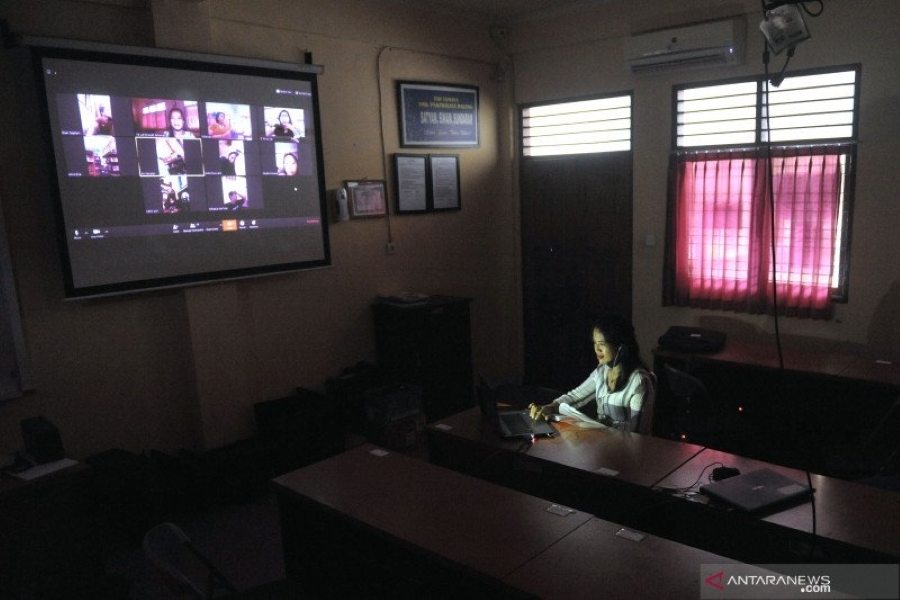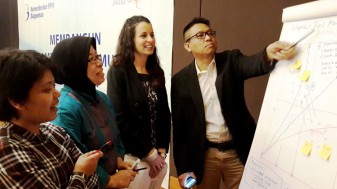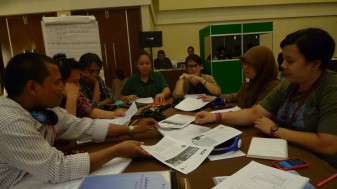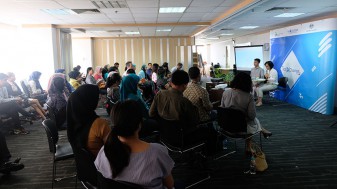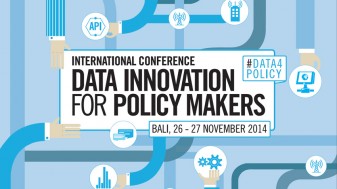The Covid-19 pandemic has forced teachers to rapidly adapt to online teaching methods. Photo by Fikri Yusuf for Antara.
The article was originally posted on Indonesia at Melbourne on August 4, 2020
Nearly four years after Indonesia passed its Law on Disability in 2016, the government has finally introduced an eagerly awaited regulatory framework for students with disabilities (Government Regulation No. 13 of 2020 on Reasonable Accommodation for Students with Disability).
This regulation requires governments at the local and national levels to assist education providers to make “reasonable adjustments” to accommodate the needs of every student with a disability, from early childhood to higher education. Giving local governments the legal responsibility to provide accessible education is also in line with Article 12 of Law No. 23 of 2014 on Local Government, which says that local governments must provide services and access to quality education from early childhood to secondary level.
To make “reasonable adjustments”, local and national (for tertiary education) governments must introduce inclusive budget planning processes. This includes allocating funds for infrastructure and tools to improve accessibility, supporting educators to develop appropriate skills and training, and developing a more inclusive curriculum.
Learning from home and inclusive education
Not long after the new government regulation was introduced, schools and universities were closed to contain the spread of COVID-19.
On 24 March, Minister of Education and Culture Nadiem Makarim issued a decision advising governors and mayors that schools should deliver education remotely, through home learning. The decision acknowledges the challenges educators and students face when studying at home and emphasises the need for teachers to pay attention to the different needs and situations of their students.
In light of these developments, the Centre for Disability Services and Studies (PSLD) at Brawijaya University and the Australia-Indonesia Disability Research and Advocacy Network (AIDRAN) conducted a survey of teachers in East Java to measure how they are accommodating the different needs of students with disabilities through online learning.
We focused on teachers of students with disabilities, at public (sekolah negeri), public inclusive (sekolah negeri inklusi, SNI), private inclusive, private, and special schools (sekolah luar biasa, SLB). The survey was conducted online, using our network with the East Java Department of Education.
Findings
Most teachers who participated in the survey were based in public schools (44%), followed by public inclusive (36%), private inclusive (14%), mainstream private (5%), and special schools (1%). The five main categories of disabilities experienced by their students were learning difficulties and intellectual disabilities, physical impairments, deaf or hearing impairments, autism, and ADHD.
To accommodate the different needs of their students, the majority of teachers said they relied on technology not just to communicate with their students and their students’ families, but also to source appropriate teaching materials. The majority (62.7%) of teachers said they gathered teaching materials from general websites, while only 32.9% of teachers used e-learning facilities developed or provided by their schools.
Teachers used platforms such as Google Classroom, WhatsApp for chatting and video calls, audio recordings, and video conference tools such as Zoom, Google Meet, and Skype to deliver their teaching and communicate with their students.
While technology is practical and provides accessibility, some teachers still use platforms that are not fully accessible. For example, we found 56.9% teachers use Microsoft Word which is an accessible platform but about 39.2% still used PDF documents, videos and voice recordings. PDF documents cannot be read by screen readers, and are therefore not accessible for the blind. Similarly, video recordings are not accessible for the visually impaired and voice recordings are not accessible for deaf students.
This survey was held about three weeks after learning from home was first introduced. By this time, about one third (34%) of teachers believed that there had been a decline in their students’ learning capacity. Almost all (99.2%) of respondents said they were experiencing serious challenges in teaching remotely, with about a quarter (26.2%) saying this was because of a lack of appropriate infrastructure and tools. Almost half (47.7%) of teachers said they needed more training on how to facilitate and accommodate the learning needs of students with disabilities. About 20.5% said they needed more training on how to use technology in their teaching.
Teachers also revealed that students with disabilities needed time to adjust to learning while not in a classroom or without close interaction with their teachers, just like students without disabilities. They also reported many students faced more distractions from their surroundings. Many parents were not in a financial position to provide their children with laptops, smartphones or reliable internet access, and were often unfamiliar with technology, and so struggled to support teaching at home.
Further study needs to be done to understand how families of children with disabilities cope with these challenges.
What lessons can we learn?
The government and education institutions are obliged to ensure students with disabilities can participate equally in education. But as our short survey has shown, they often lack the policies, knowledge and infrastructure to guarantee access for students with disabilities.
The Covid-19 pandemic and the move to online learning has demonstrated that education providers are still struggling to provide “reasonable adjustments” to students with disabilities. It is important to note, however, that teachers, including those who are not teaching in inclusive schools, are making efforts to accommodate the needs of their students.
One positive outcome of the pandemic is that the move to online learning has forced more teachers to get up to speed with technologies that can improve accessibility. Teachers have been challenged to improve their teaching skills. But as our survey demonstrated, many still need training on how to use technology to ensure inclusion of students with disabilities.
The move to online learning has revealed gaps in providing inclusive education and reasonable adjustments. The government should capitalise on the momentum of the pandemic and provide the tools, training, and access to resources to support teachers to make education accessible for all students.
Given the financial constraints on the government because of COVID-19, and the lack of support it has provided teachers to respond to the crisis to date, teachers are not holding their breath.

